- Paligo Documentation
- Author
- Paligo Metadata
Paligo Metadata
Paligo provides metadata about the various types of content you have in your instance, including publications, topics, and admonitions. This metadata can be useful when you want to find out more about a component, such as a topic, and its relationship with other content in the database. For example, you can open a topic and use the metadata to find out which publications it appears in.
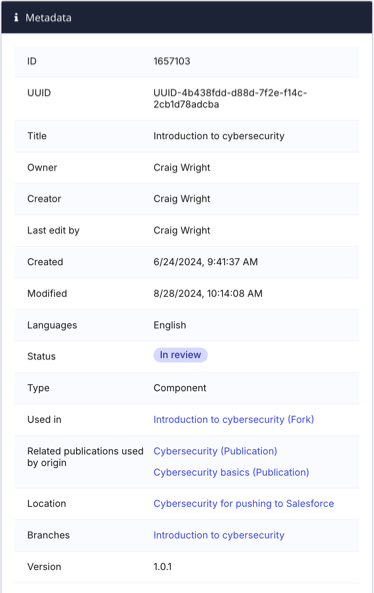 |
Display Paligo Metadata
There are several ways to display Paligo metadata, depending on whether you want metadata for a component, publication, or folder:
Select a component, such as a topic or informal topic, in the Content Manager to display it in the main editor. The editor has a Metadata side panel.
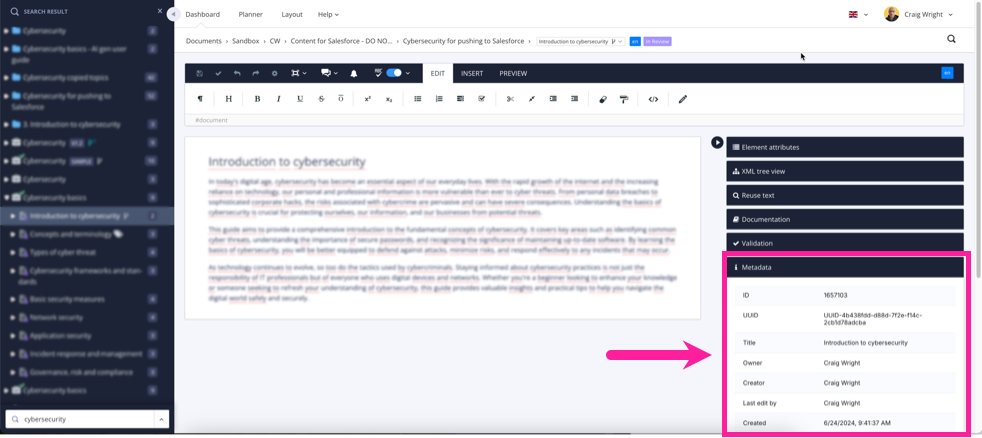
Note
The Metadata side panel is currently text-only. It does not provide options for changing the metadata, such as changing the Owner. These options are only available when you display the metadata from the Content Manager.
Select the dotted menu ( ... ) for a component, such as a topic, in the Content Manager. Next, select Edit and then Open structure. The structure view has a Metadata section.
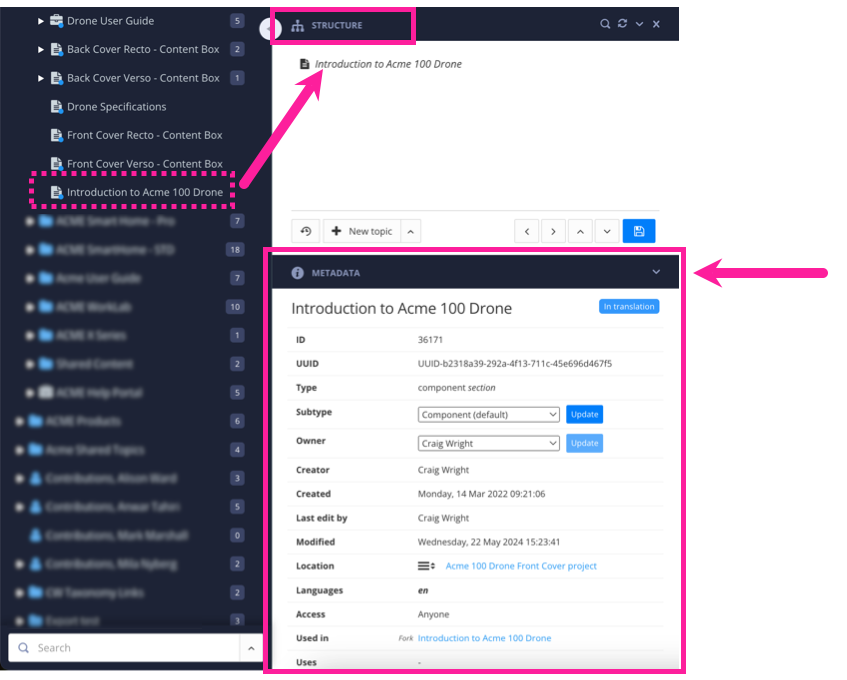
Select a publication in the Content Manager to open its structure view. The structure view has a Metadata section.
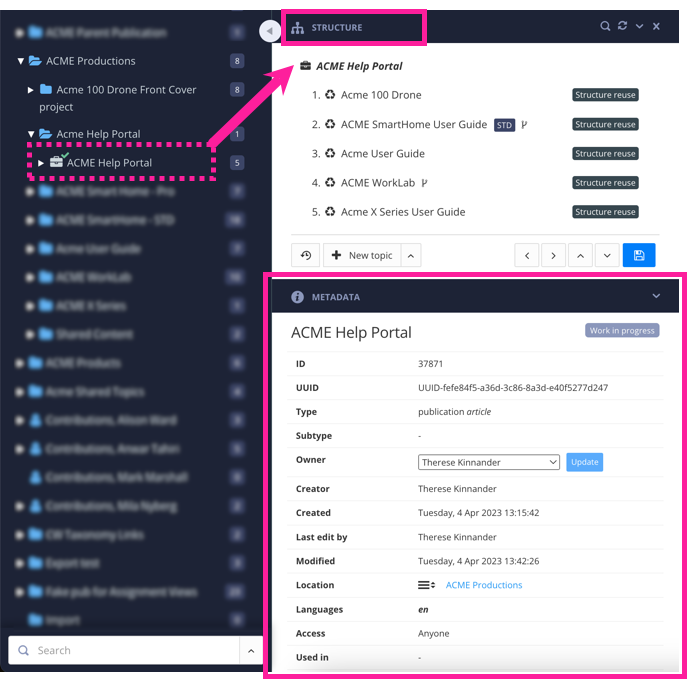
Select the dotted menu ( ... ) for a folder and then select Metadata.
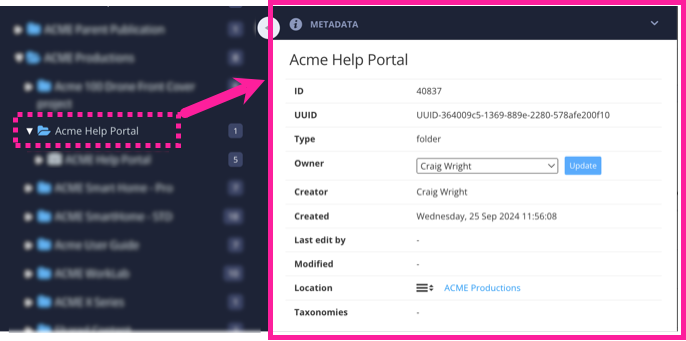
For information on the possible metadata properties and values, see Paligo Metadata Properties . Note that you will only see metadata entries that are relevant to the type of content you have selected.
Paligo Metadata Properties
The Paligo metadata has many properties, and they vary depending on what type of content you are viewing. You will only see metadata properties that are relevant.
The possible entries are described in the sections below.
ID
A unique number. This is the database ID for the component.
UUID
Universally Unique Identifier. This is a 128-bit number that Paligo uses to identify components both internally and externally.
Type
This is the kind of component you are viewing. The main types of component are:
Publication
Publications have article as their root element.
Component
This is a general term for many types of component, including topics and informal topics.
The root element varies, depending on the type of component. For example, a topic has section as its root element and an informal topic has sidebar as its root element.
Admonition
This covers the various types of admonition, including note, caution, and warning.
The root element for an admonition shows the type of admonition, for example, note.
Fork
The component is a reused component, such as a reused topic.
The root element for a reused component varies depending on the type of reused content. For example, a reused topic will have fork as its type and section as its root element.
Folder
The component is a folder. It does not have a root element.
Note
Reused topics are called a fork but reused informal topics are called a component.
Subtype
The Subtype shows that the component has a further level of categorization, such as:
Appendix
Topic
Cover
Informal topic
Itemizedlist
Simplelist
Step.
Your Paligo may have additional subtypes, especially if your instance has a customization.
Note
Paligo only supports changing a Subtype from:
Topic to Informal topic
Informal topic to Topic.
You cannot change other Subtypes.
Used in
The name of the parent component (shown when you are looking at the metadata for a reused component, so the Type is fork).
Reused here
This shows any components or images that are reused inside the selected component.
Links to
This shows any cross-references made from this component to other components. For example, it could show a cross-reference from one topic to another topic.
Links from
This shows any cross-references from other components to this component. For example, it could show a cross-reference from another topic to the currently selected topic.
Origin
The original component of the selected fork.
Related publications used by origin
This shows any publications that also use the origin of the selected fork.
Taxonomies
This shows the taxonomies that are used by the selected component.
Version
The internal Paligo version of the selected component.
Branch of
The source branch of the selected component (only shown if the component is a branch).
The source branch is the branch from which the current component was created.
Branches
The branches of the selected component. These are branches made from the selected component.
Owner
The user that creates a folder or component is the "owner" by default. Only owners and administrators can control the permissions for a folder or component.
But it is possible to change the owner to another user, if needed. To find out more, see Change Component Owner.
Creator
The user that created the folder or component.
The Creator is the same as the Owner by default. But it may be different if someone has changed the Owner metadata (see Change Component Owner).
Created
The date and time at which the folder or component was created.
Last edit by
The name of the user that made the most recent edit of the component.
Modified
The date and time of the most recent edit of the component.
Location
The folder that contains the currently selected content.
You can change the location to a different folder if required.
Languages
The languages that have been added to the component.